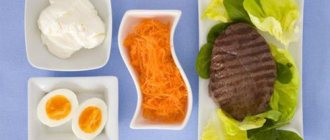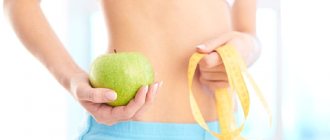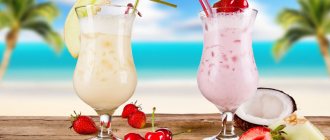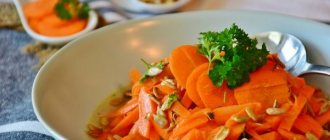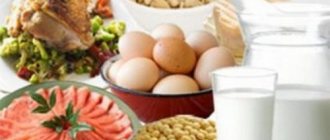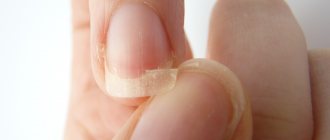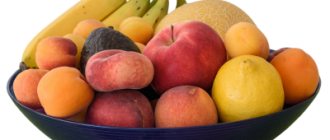- July 21, 2018
- Diets
- Ekaterina Loza
In this article we will look at how many calories you need to gain weight.
A high-calorie diet is based on the principle of increasing calorie content. Every day you need to eat at least one hundred calories more than the previous day, and you should eat at least four small meals a day. Many people are interested in how many calories it takes to gain weight. This diet assumes that a person’s weight will increase thanks to foods rich in carbohydrates and proteins. These can be various porridges with milk, vegetable and cottage cheese casseroles, as well as meat. You can also eat butter, different types of cheese, cream, sour cream, and, in addition, delicious pastries and sweets. It is considered normal if a person gains one kilogram per month.
So, let's take a closer look at how to gain calories.
The best products for gaining muscle mass: calorie content, nutritional value, description, options for use
There are no exotic products in the dietary “basket” for weight gain.
It is enough to create a diet based on the usual meat, poultry, fish, cereals and dairy products. An excellent addition would be vegetables, fruits, nuts and very dosed fats.
The diet will lead to the desired result with the following balance of nutrients - BZHU (proteins/fats/carbohydrates):
- 35/15/50 – growth of muscle mass. Used in the nutrition of professional athletes, also suitable for men.
- 25/15/60 – moderate increase in muscle volume in combination with physiological fat. Recommended for women and girls who exercise at home, in fitness clubs, and amateur sports clubs.
Depending on individual characteristics, deviations within 10-15% are acceptable.
BJU and calorie content
A table of the biological value of foods will help you create a balanced menu.
| Product | Squirrels | Fats | Carbohydrates | Water | Energy value, kcal |
| Dairy | |||||
| Whole milk | 2,7 | 3,2 | 4,3 | 87,1 | 58 |
| Cheese "Russian" | 22,4 | 30 | 41 | 368 | |
| Cheese "Dutch" | 25,8 | 28,3 | 37,8 | 358 | |
| Cow's milk cheese | 17,9 | 20,1 | 52 | 262 | |
| Bakery products | |||||
| Bread made from premium flour | 7,7 | 2,4 | 53,4 | 34,2 | 254 |
| Rye bread | 4,6 | 0,7 | 49,6 | 42,4 | 213 |
| Baranki | 10,3 | 1,4 | 68,5 | 18 | 314 |
| Drying | 12 | 1,4 | 72 | 14 | 329 |
| Cereals | |||||
| Buckwheat (kernel) | 12,6 | 2,6 | 67 | 15 | 330 |
| Rice | 8 | 0,7 | 74,6 | 15 | 322 |
| Millet | 11 | 2,8 | 69,2 | 15 | 334 |
| Oats | 11,8 | 5,9 | 65,2 | 12 | 346 |
| Hercules | 12,9 | 6,3 | 64,8 | 12 | 362 |
| Semolina | 11,3 | 0,7 | 72,2 | 14 | 327 |
| Oil and fat products | |||||
| Pork lard | 1,4 | 92,6 | 5,7 | 816 | |
| Sandwich margarine | 0,5 | 82 | 1,2 | 15,7 | 738 |
| Mayonnaise | 3,1 | 65 | 2,8 | 24 | 623 |
| Butter | 0,6 | 82,3 | 0,9 | 15,8 | 752 |
| Vegetable oil | 98,9 | 0,1 | 876 | ||
| Vegetables | |||||
| White cabbage | 1,8 | 5,2 | 90 | 35 | |
| Cauliflower | 2,6 | 4,7 | 89,7 | 28 | |
| Eggplant | 0,6 | 0,2 | 6,2 | 92 | 23 |
| Zucchini | 0,6 | 0,3 | 5,9 | 94 | 28 |
| Potato | 2 | 0,1 | 18 | 76 | 89 |
| Carrot | 1,3 | 0,1 | 8 | 87,6 | 32 |
| Beet | 1,8 | 10,9 | 86,4 | 47 | |
| Green peas | 4,9 | 0,2 | 13,7 | 80 | 72 |
| Red beans | 4,1 | 4,5 | 89 | 34 | |
| Meat/poultry | |||||
| Beef | 18,8 | 12,3 | 67,8 | 187 | |
| Pork | 11,5 | 49,7 | 38,7 | 489 | |
| Mutton | 16,4 | 15,6 | 68,4 | 205 | |
| Chicken | 20,7 | 8,9 | 0,2 | 68,9 | 167 |
| Duck | 16,2 | 60,9 | 51,2 | 349 | |
| Goose | 15,9 | 33,2 | 49,5 | 367 | |
| Turkey | 21,6 | 11,8 | 0,7 | 64,2 | 194 |
| Fish | |||||
| Pollock | 15,8 | 0,7 | 80,2 | 70,1 | |
| Tuna | 22,4 | 4 | 73 | 98 | |
| Mackerel | 18 | 9 | 72,7 | 149 | |
| Whitefish | 18 | 7,6 | 72,1 | 147 | |
| Eggs | |||||
| Chicken | 12,9 | 11,2 | 0,7 | 73 | 158 |
| Powder | 46 | 36,9 | 8,1 | 6,8 | 539 |
| Protein, dry | 73,8 | 2,1 | 7,2 | 12,1 | 327 |
| Yolk, dry. | 33,9 | 51,7 | 4,6 | 5,6 | 619 |
| Nuts | |||||
| Gretsky | 13,2 | 61 | 10,7 | 5 | 647 |
| Peanut | 26,1 | 44,9 | 9,7 | 10,2 | 543 |
| Hazelnut | 15,9 | 67,1 | 9,7 | 4,7 | 712 |
| Sunflower seeds | 20,3 | 53,4 | 5 | 9 | 576 |
Biological significance of nutritional components:
- Proteins (proteins) are the main building material of tissues, including muscle tissue. Support of immunity and biochemical reactions, storage of genetic information is also due to these substances.
- Fats provide energy, participate in hormonal metabolism and regulate the functioning of the nervous system.
- Carbohydrates (polysaccharides and monosaccharides) – support energy metabolism and promote the absorption of proteins. They provoke the release of the hormone insulin, a natural anabolic that stimulates muscle growth.
An imbalance of BJU has a bad effect on the results of weight gain and leads to serious disruptions in the body.
Note! Excess protein causes putrefactive processes in the intestines, malfunctions of the heart, kidneys and liver. An excess of fast carbohydrates (flour, sugar, chocolate) increases subcutaneous fat deposits and reduces immunity. Excess fat inhibits the absorption of proteins, reduces metabolic processes, and leads to obesity.
The energy value of food (measured in calories/kilocalories) is important. More calories should be received than a person expends per day. A low-calorie diet is dangerous because the body strives to adjust energy metabolism using its own protein compounds.
Brief description of products by groups
Meat, poultry, fish. Sources of complete protein and essential amino acids that the body cannot produce on its own. The basis of the diet in weight gain diets.
Dairy products. They contain complex proteins with optimal vitamin and mineral composition. Calcium and vitamin D, necessary for gaining “muscle” weight, are presented in an accessible form.
Cereals. They provide energy and are rich in fiber, vitamins and minerals. Due to the content of complex carbohydrates, a feeling of satiety is ensured for several hours.
Vegetables/fruits, food herbs. Source of vitamins, minerals, biologically active substances. The symbiosis of organic compounds promotes the absorption of proteins and normalizes metabolic processes. Vegetables and fruits can be eaten as a side dish or prepared as fruit and vegetable juice.
Nuts. Recognized suppliers of carbohydrates, vegetable fats and protein compounds.
Vegetable and animal oils. They supply fat-soluble vitamins A, D, E. These compounds activate anabolic hormones, which determine muscle growth and bone strengthening. Fat is also the first “fuel” for the body during physical activity and in cold weather.
Weight gain, or how to achieve balance
There are many different reasons why excessive thinness occurs. This is a genetic predisposition, and an overly active lifestyle, along with a lack of diet, stress, depression, chronic diseases, and so on. Some diets lead to weight loss, while others, on the contrary, can be used to gain weight. But what should be the diet for weight gain in men and women?
When it comes to this kind of figure improvement, the most obvious decision seems to be to eat everything that standard diets prohibit, that is, fatty, sweet and salty. True, this will definitely not lead to anything good, except for diseases of the digestive system.
The maximum that a person can achieve is, most likely, edema with a slight increase in fat mass. And this is not the purpose of a weight gain diet, regardless of whether it is a man or a woman. The main goal is to develop muscle mass and strengthen bones. Therefore, when choosing the right diet, they rely on protein products. This effect can be enhanced by working out in the gym.
So, what should be included in the diet? How many calories does it take to gain muscle mass? The daily calorie content of the diet menu should reach 3000 calories. Gaining weight will not be difficult. But the final figure depends on gender, and, in addition, on age and individual characteristics of the figure. To cover the need for fat, nutritionists recommend consuming approximately three tablespoons of vegetable oil per day.
In addition, to achieve the desired proportion, it would not be amiss to introduce pasta into your diet along with sugar, honey, beans, flour products and sweet fruit juices, which should be drunk in the amount of one glass immediately before each meal. How many times a day should a person eat? Nutritionists recommend the classic five-a-day regimen with a gradual increase in calories.
How many calories do women need to gain weight? What to eat?
Rice: a cheap food to quickly gain muscle mass
Rice, as a source of complex carbohydrates, provides energy to the body.
Its carbohydrate composition is up to 97% represented by starch, which is slowly broken down and evenly enters the bloodstream. Rice porridge in the morning will provide a feeling of fullness for 3-4 hours, and a lunch side dish of white rice will add tone for another 2 hours.
Protein and fat composition:
- proteins include 12 essential amino acids that the body cannot produce on its own;
- 78% fat consists of polyunsaturated compounds;
- the protein/fat ratio is clearly in favor of the first nutrient - 8 g to 0.7 g per 100 g of raw cereal.
Rice fiber has excellent adsorbing properties, so rice cleanses the body of accumulated toxins. As a result, food absorption and overall well-being improves.
Buckwheat: tasty, healthy, one of the best foods for weight gain
The optimal biochemical composition, high nutritional value and excellent taste have placed buckwheat among the top dietary products.
A serving of buckwheat garnish is:
- vitamins of group B (B1 B2 B5 B6 B9), E, H, PP, A;
- essential minerals - potassium, magnesium, selenium, zinc, manganese, chlorine, iodine, chromium, fluorine, molybdenum, boron, vanadium, tin, copper, iron;
- carbohydrates: mono- and disaccharides;
- protein compounds;
- bioactive substances - Omega-3 polyunsaturated acids, phytoestrogens, phospholipids, flavonoids, organic acids.
100 grams of raw cereal contains 12-15 g of protein. Due to the presence of 8 essential amino acids, their biological value approaches 80%.
Nutrients work in combination: vitamins and minerals “help” each other to be absorbed, and together they act on proteins.
Peanut butter: high in calories and protein
One tablespoon of peanut butter provides almost 90 calories.
The product contains mainly unsaturated Omega fatty acids (“good” fats), and the cold-press technology allows you to transfer all the beneficial properties of peanut kernels:
- vegetable proteins: per 100 g of oil there are 20-25 g of easily digestible protein compounds;
- vitamin and mineral composition: of particular value are fat-soluble vitamins A, D, E, K, which are involved in the biochemical processes of muscle formation and preservation;
- sterols, phospholipids, antioxidant compounds, fiber.
A piece of coarse bread, flavored with a spoon of butter, will become a complete snack during the day. For bodybuilders, this is a way to close the protein-carbohydrate “window” after an intense workout.
Bananas: a hearty snack on the go
A banana contains on average 2-3 bread units (20-25 g of carbohydrates). Thanks to this, you can eliminate the sudden feeling of hunger without overeating.
To replenish energy during the day, it is enough to eat 2-3 bananas. Also, a banana snack is an effective restoration of electrolyte balance after a workout due to its high calcium and potassium content.
Interesting fact! Bananas are called the fruit of good mood because their pulp is rich in endorphins. But a smooth emotional background underlies correct metabolic processes during weight correction.
Low calorie foods
Products (30-99 kcal per 100 g) of the low-calorie group:
Kefir, milk, low-fat cottage cheese, yogurt 1.5% and 3.2% fat, curdled milk, kumiss, - hake, cod, pike perch, carp, pike, flounder, - fruits, berries (except cranberries), - rutabaga, cabbage, green peas, potatoes, carrots, radishes, beans, beets.
Extremely low calorie content of products (less than 30 kcal per 100 g):
cabbage, broccoli, zucchini, cucumbers, turnips, radishes, lettuce, sweet peppers, tomatoes, pumpkin, fresh mushrooms, cranberries.
Calorie content of foods and weight loss
It is very important to take into account the caloric content of the diet for those who want to lose weight quickly and effectively. Only in this way is it possible to properly regulate the energy balance in the body.
When purchasing products, pay attention to the packaging, as it always displays information about exactly how many calories the product contains. And already when preparing food, if it combines several different products, it is necessary to carefully calculate the final energy value of the resulting dish. This calculation is made by simply adding all the ingredients of the dish.
For example, you want to cook buckwheat porridge:
The calorie content of buckwheat indicated on the package is 335 kcal per 100g. You take 100 g of dry buckwheat. Add water 2:1, that is, 200 g. And then fry 50 g of onion (45 kcal per 100 g) in 20 g of oil (900 kcal per 100 g). Total:
Product Weight (g) Kcal/100g
Buckwheat 100 335
Oil 20 900
Total: 370 (335*1+0*2+45*0.5 +900*0.2)/3.7=139.2
Thus, the energy value of buckwheat porridge will be 139.2 kcal per 100 g.
Gradually, over time, an individual plate will be created with the most common set of dishes, in which information about the calories of your entire daily menu will be entered. By grouping all these calculations, you can greatly simplify the process.
We figured out how to count calories, but it’s much more important to decide where to put them. The bulk of the energy of a modern sedentary person (over 60%) is spent on building the structure of the body. He spends very little on physical activity - 25-30%, but should be about 50%. The danger is not even that they began to eat more fat, but that they began to move less. Nowadays, 5-8% of the population leads an active lifestyle. Man has immobilized himself (cars, elevators, TV, even power steering) and has reached the lower limit: energy expenditure is only 2000-2500 kcal per day - these are already critical figures. If this continues, people will develop muscular dystrophy, lethargy, the risk of obesity will increase by 3-5 times, followed by problems with the heart and blood vessels, diabetes...
Knowing the calorie content is necessary to calculate the energy value that a person consumes throughout the day. According to published data, on average a woman loses about 2200-2600 kcal per day, provided that she leads a so-called “average” lifestyle. That is, she does not actively engage in sports, and at the same time, her daily routine is not passive.
To increase energy expenditure, you need to regularly perform various physical exercises to lose weight and lead an active lifestyle - rollerblading, cycling, running, swimming, aerobics, dancing, etc.
Below are the types of activities that will allow you to get rid of approximately the following amount of calories in one hour:
Aerobics - 420 kilocalories; — Swimming — 250-400 kilocalories; — Jogging — 500-600 kilocalories; — Fast walking — 450-480 kilocalories; — Cycling — 250-450 kilocalories; — Basketball — 300-350 kilocalories; — Bowling — 220 kilocalories; — Dancing — 150-250 kilocalories; — Ice skating (roller skating) — 200-250 kilocalories; — Tennis — 400 kilocalories; — Jumping rope — 400-450 kilocalories; — Trouble in the kitchen — 70-90 kilocalories; — Work on a personal plot — 100-120 kilocalories; — Climbing up the stairs — 500-700 kilocalories.
Simple carbohydrates, which we eat with buns, fruits, honey, sugar, etc., begin to break down immediately, while still in the oral cavity. The remaining unprocessed carbohydrates will be deposited in the liver as fatty deposits. If you ate 2 extra pieces of sugar (about 10 g), that's about 40 kcal. Almost 3 g of fat is synthesized from them. If these extra pieces are consumed daily, they will be enough to gain more than 1 kg of excess weight within a year.
As you know, proteins and fats are used for thermoregulation, renewal, growth and regeneration of tissues.
To provide the body with the necessary chemicals per day, you need to consume at least 400 grams of carbohydrates, 80 grams of protein and 100 grams of fat.
Thus, knowing exactly how many calories are consumed per day and how many are expended, you can influence the weight loss process. To do this, you just need to choose the most suitable diet, control calories when cooking and spend them in the required quantity, lead an active lifestyle and exercise.
We get these vital substances from staple foods, so it is advisable to know their exact composition.
Using a food calorie table, you can undoubtedly improve your diet and make your diet healthier, but you can’t put everyone in the same category. It is best to consult with a nutritionist who will calculate your personal daily diet according to your gender, body composition, type of activity and goals.
Tuna: Protein-rich food with healthy fats
The representative of mackerel fish is the leader in the content of complete protein. A 100 g serving of fish fillet provides 22-25 g of protein, which is almost half the daily requirement.
At the same time, absorption approaches 95%. There is little fat: only 3-4 g, but all of these are polyunsaturated compounds. Omega fats support the functioning of the cardiovascular system, resist the formation of blood clots, and normalize metabolism.
Important! Tuna is an indispensable aid for people seeking to build muscle size. Fish oil breaks down excess fat deposits, increases protein synthesis and promotes the growth of lean muscle mass.
Whole milk/soy milk: fast, cheap and convenient
Whole milk is a natural gainer that can be purchased at your local store. To get the necessary minerals, vitamins, fats/carbohydrates, just drink a glass of milk (230 ml). There are not many proteins in this portion - only 8 g, but they contain a full complex of amino acids that are quickly absorbed and activate muscle weight gain.
If you are lactose intolerant, soy milk, made from soybeans, is an alternative. The drink looks and tastes like regular milk, but the nutritional value is different.
Composition per 100 g:
- soy protein – 3.79 g;
- carbohydrates – 3.15 g;
- fats – 1.96 g;
- sugar – 2.5 g;
- fiber – 0.7 g.
Soy milk contains B vitamins, fat-soluble compounds D and E. The ratio of calcium, potassium and sodium (140/141/57 mg, respectively) is optimal for gaining muscle mass.
Note! Due to the content of mineral salt ions, whole and soy milk can replace isotonic drinks. A “liquid” snack will restore the alkaline balance after an intense workout or hard workout.
Chicken: cheap source of protein, ideal for bulking
Chicken meat is the most affordable source of proteins. But the dietary value is primarily provided by breast fillet (“white” meat).
100 g of product contains:
- 31-35 g protein;
- 3-4 g fat;
- 120 kcal.
There are many B vitamins involved in amino acid metabolism and various minerals. The protein-fat composition is ideal for including “white” chicken in muscle-building diets.
Nuts and nut butters as a source of energy
Walnuts (or peanuts) and walnut butter are a great food for anyone looking to gain weight in a healthy way. This product contains proteins and healthy fats. Use nuts as a snack, add to salads or other dishes. When it comes to nut butter, it is better to choose a 100% natural product, without adding extra sugar or preservatives. You can eat it with sandwiches.
Found a violation? Report content
Eggs: High-calorie food for fast weight gain
Rarely is breakfast complete without boiled eggs, omelettes or fried eggs, and it’s not just a matter of availability and speed of preparation. High nutritional value is what the poultry product is valued for.
An average egg weighing 55-80 g contains:
- 12.9 g protein;
- 11.5 g mono- and polyunsaturated fats;
- 0.7 g of carbohydrates and about the same amount of saccharides;
- 3 g saturated fatty acids and 540 mg cholesterol.
These substances act as energy suppliers, providing only 150-160 kcal, and 17 vitamins and 14 mineral compounds allow eggs to be classified as natural dietary supplements.
Important! Due to the high concentration of cholesterol and fatty compounds, chicken eggs “in their pure form” should be consumed moderately – 1-2 eggs per day.
To quickly gain lean weight (muscle), the number of eggs can be increased. You just have to optimize the protein-fat balance.
The yolks are separated from the whites and used in a ratio of 3 parts whites to 1 yolk, which is comparable to a protein shake.
Dark chocolate: antioxidant-rich food for weight gain and good mood
Chocolate is classified as dark if it contains 70-85% grated cocoa beans and cocoa butter.
Due to the high content of protective and stimulating compounds, the fruits of the chocolate tree give the dessert unique properties:
- Antioxidants stop the oxidative processes that occur in the body during physical activity and resist the harmful effects of free radicals at the cellular level.
- Flavonoids support the functioning of the cardiovascular system and metabolic processes, relieve inflammation. Epicatechin deserves special attention. The substance promotes the regeneration of muscle fibers after training and moderate muscle growth.
- Peptide compounds tyramine and tryptophan normalize the activity of the thyroid gland, participate in metabolism, and break down excess fat. Tryptophan also produces endorphins (hormones of “good mood”), which normalizes the emotional background.
There are 546-500 Cal per 100 g of chocolate. The composition contains theobromine, caffeine, phenylethylamine and cannabinoids - stimulants that increase physical endurance and mental activity.
Note! Chocolate cannot be called a product of the everyday menu. Rather, it is a nutritional supplement and a delicious dessert that should not be eaten in packages. 2-3 cells will completely cope with the loss of strength and will significantly improve your mood.
Advantages
For athletes, it is extremely important to monitor nutrition, creating the most varied and tasty menu possible. Everyone knows about the need for protein for muscle growth, so they try to eat enough meat, fish, and eggs. However, for mass gain, cereals are also required, which should make up 1/3 of the athlete’s daily diet.
The need is due to the positive properties that cereals have:
- These are slow carbohydrates that satisfy hunger for a long time. They provide a gradual release of energy necessary for physical activity and high-intensity and effective training.
- Rich composition, which includes digestive enzymes, amino acids, protein, micro- and macroelements. They do not overload the digestive system and do not cause a negative reaction from the gastrointestinal tract.
- The opportunity to prepare a variety of dishes that will be not only healthy, but also tasty.
- A large range of products and affordable prices, which allows you to diversify the menu and make it balanced.
Cheese: what would life be like without it?
The tart cheese taste is appreciated by gourmets, and the balanced composition is appreciated by nutritionists. The product is especially useful for weight gain, as it increases the calorie content and nutritional value of the diet. Cheese is good for a healthy snack during the day, an energy boost after a workout, and, of course, as part of breakfast.
The biological value of the product is explained by its dairy “origin”, but due to its dense consistency, the content of BJU, vitamins and minerals in the cheese is higher.
100 g of popular varieties contains:
| Type of cheese | Protein, g | Fat, g | Carbohydrates, g | Calorie content, Cal |
| Mozzarella | 27,23 | 20,78 | 5,47 | 285 |
| Cheddar | 25,36 | 33,27 | 3,12 | 405 |
| Parmesan | 36,64 | 25,74 | 3,24 | 387 |
| Feta | 14,32 | 21,18 | 4,32 | 258 |
Cheese is a record holder for the content of protein, calcium, phosphorus and sodium. Minerals strengthen the musculoskeletal system, support heart function, and vitamin D promotes their complete absorption.
Soybeans: Source of Protein and Calories, Cheap Weight Gainer
Soybeans are readily available, inexpensive and easy to prepare, allowing them to be included in the main diet.
The value of the product lies in its high protein content and optimal carbohydrate-fat composition:
- a hundred-gram serving of boiled seeds provides 18.2 g of protein, 7.89 g of carbohydrates, 8.93 g of fat and 178 kcal;
- Most soy proteins are comparable in nutritional value to animal protein, as they include 9 essential amino acids.
Soybeans increase cell permeability for the absorption of amino acids and carbohydrates and create an anabolic effect.
The level of nitrogen (the most important component of proteins) rises in the blood, and the body begins to accumulate protein. A state of positive nitrogen balance is a condition for increasing muscle mass.
Almonds[edit | edit code]
Almonds contain the highest amount of protein of all nuts, at 18 percent. And it contains almost no carbohydrates, which makes this nut an almost indispensable food product for diabetics. However, for you and me he is even more indispensable. Thanks to the balance of fats and proteins, it allows you to satisfy hunger for a long time, control blood sugar levels and, in addition, maintains the health of blood vessels and helps remove excess cholesterol. In addition to protein, there is a lot of vitamin E, there are microelements such as magnesium, potassium, zinc, iron, and a large amount of dietary fiber. There is also quite a lot of calcium here - more than in other products of plant origin. So those who do not digest milk and do not eat dairy products can easily use almonds as a source of this essential microelement. Moreover, now they are increasingly saying that calcium is almost not absorbed from dairy products in adults, even if there is no pronounced bad reaction to them. Despite the fact that almonds are a high-calorie product, they are actively used as one of the main components of nutrition for weight loss (including because it helps control appetite and prolong the feeling of fullness). Recent studies show that those who regularly eat nuts, especially almonds, have lower weight compared to those who avoid nuts. In Chinese medicine, almonds have been used since ancient times as an antispasmodic and anti-inflammatory substance, and they were often also used as a tonic. So for you and me - even those (and maybe especially those) who are on a strict diet, almonds are almost irreplaceable.
Everyone knows what peanut butter is (although it's more correct - paste), but there is also almond butter, which is as healthy as the nuts themselves, but perhaps has a little more use. Pay attention to the composition: natural paste contains only nuts - no oils, sugars or water. Then this is a dietary product.
Sports nutrition
Sports (functional) nutrition – nutritional supplements for correcting the diet and balancing body weight.
It contains proteins, amino acids, fast carbohydrates, healthy Omega fats, vitamins and minerals in optimal proportions, so nutrients are absorbed almost completely. The inclusion of anabolic steroids and synthetic metabolic stimulants is prohibited by Russian law.
Sports supplements are presented in the form of dry mixtures, nutritional bars, and dietary supplement capsules.
The mixtures are diluted depending on preferences with water, milk, juices, whey, and the protein shake is ready. It is added to breakfast, lunch or dinner, increasing the nutritional value and nutrient absorption of the main menu. For better “work” of supplements, regular training in the gym or walking in the fresh air of 10-12 km is recommended.
Important! A protein shake is not a substitute for a regular diet. A balanced diet based on the right foods for weight gain is a must.
Tips on how to gain weight quickly
What will help you gain weight. Adviсe:
- Eat small portions, but often. Overweight people, as a rule, constantly chew something. Thus, the pancreas will be unloaded and the functioning of the stomach will be normalized. As you know, eating rarely but in large portions is harmful.
- Drink fruit smoothies and cocktails instead of water. Make natural juices. Drink milk if there are no contraindications.
- It should be noted that simply gaining weight will lead to deformation of the figure. Try to combine a high-calorie diet with exercise. In this case, focus on strength exercises rather than exhausting yourself with running or fitness.
- Carefully count the calories you eat. In order to gain weight, five hundred calories are added to the daily norm without taking into account physical activity.
- Keep a diary where you compare the number of calories you eat and your weight gain over the week. Nutrition should be complete and varied. Alternate meals in your diet.
- Nutrition should be your priority. If you are in a hurry somewhere and, out of old habit, ignore lunch or an afternoon snack, then the effect will not come soon.
- Porridge, sweet fruits, fatty dairy products and nuts should always be in your daily diet.
- Healthy and long sleep is the key to success. Lack of sleep has a negative impact on your health. Moreover, a person prone to obesity will gain weight from lack of sleep, while a thin person, on the contrary, will lose weight.
- Make it a rule to choose high-calorie foods. Add potatoes and beans to your meals instead of herbaceous celery. Add sour cream to soups and more butter to porridges. So, you will receive an additional portion of vitamins A and E, which are responsible for smooth skin and visual acuity.
- Love peanut butter and cheese. These products are not only high in calories, but also incredibly healthy.
Once your weight is corrected, it should be maintained at a certain level. To prevent it from gaining further, and you don’t end up becoming fat, return salads made from fresh carrots, celery and other low-calorie foods to the menu. Limit your cocktails and drink more regular still water.
Problems that arise when you are thin
Remember that thinness carries with it a lot of unpleasant moments both for appearance and for general health. An underweight person has the following problems:
- Bad hair and early gray hair. Our hair is nourished on a residual basis. That is, in order for them to be in good condition, you should lean on legumes, butter and dairy products. Moreover, one or two cottage cheese dishes a week will not save the situation.
- Insomnia and increased nervousness indicate a catastrophic lack of B vitamins, which are found in cereals and bread. By ignoring the consumption of cereals, a person exposes himself to the danger of a nervous breakdown.
- A lack of microelements affects the state of bone mass. Thin people are more likely to break their arms and legs.
- Chronic fatigue or apathy appears.
- Poor skin and brittle nails, dry hands and feet also indicate lack of nutrients.
- Poor immunity and, as a result, many diseases.
According to doctors, the problem of underweight worries men more than women . Nature instructs men to be strong and strong in order to protect themselves and their families. With an asthenic physique, this will be very difficult to do. Lack of muscles and general weakness in the body often make him lack self-confidence. You will have to build muscle only with correction of your diet and lifestyle.
Weight Gain Products
There are foods and special diets that can help with this. They help increase muscle mass rather than deposit fat. All of them are healthy and high in calories, which will improve your health and add energy. .
- First of all, cereals, of which oatmeal and buckwheat can be distinguished.
- All types of nuts.
- Dark chocolate is a source of thiamine.
- Fat meat.
- For vegetable oils, choose olive or avocado oil.
- All dried fruits.
- Potato.
- Dairy products should be high in fat.
- Peanut butter.
Don't just focus on these products and ignore the rest. Dilute your weight gain menu with fresh fruits and vegetables. Give preference to juicy fruits that do not require long chewing .
Prepare yourself a nutritious cocktail: a pack of cottage cheese is mixed in a blender with cream and two tablespoons of honey and jam are added.
What mass is needed? Clarifying the goal
When gaining weight, the goal is the same - a beautiful body with developed muscles and a small layer of fat. But the ways to achieve what you want depend on your body type.
There are three body types:
- Ectomorphs are excessively thin, with long limbs and an elongated torso. The muscles are poorly developed and difficult to create; there is no fat layer observed. Rapid metabolism prevents you from gaining weight. The calorie content of food is important here due to the inclusion of a large proportion of carbohydrate foods in the diet.
- Endomorphs tend to accumulate fat at the expense of muscle. The shapeless figure often resembles a pear. This type should eat mainly protein foods with moderate carbohydrate content.
- Mesomorphs easily form a beautiful relief, where every muscle is developed and there is no excess fat. Their body is distinguished by correct proportions and the ratio of muscle-fat tissue. For a mesomorph, it is enough to balance the diet according to BZHU, properly distribute meals and “sweat” a little in the gym.
Determine the required calorie content of foods
Determining the required caloric content of foods
It is more correct to talk about the required caloric content of the daily diet. It is determined by the morphological type of a person, daily routine and weight gain goals. If the diet is designed primarily for the formation of muscle mass, 5000-6000 kcal should be supplied per day. The more powerful the physique, the more energy is required.
When a person simply strives to gain the missing kilograms without any sporting ambitions, the bar is 4000-4500 kcal. However, everything here is too individual, so you will have to start from general recommendations: for every kilogram of initial weight you need to “eat” 25-45 calories.
Calorie counting in foods
- Calories determine a person's need for energy.
- Rule: in the supermarket you need to carefully study the labels on products and choose low-calorie foods (cabbage, cucumbers, tomatoes, zucchini, radishes, cranberries). Then you can easily reduce the calorie content of your daily diet by 200 kcal!
- It must be remembered that the lowest-calorie foods contain a lot of water.
- Keeping a food diary is encouraged, where everything that is eaten during the day is recorded down to the nearest gram.
The calorie content of any product is determined by the proteins, fats and carbohydrates it contains. The most high-calorie foods consist of large amounts of carbohydrates and easily digestible fats.
Based on calorie content, it is reasonable to divide products into three groups:
- fat-containing;
- carbohydrate-containing;
- protein.
Fats contain 2 times more calories than proteins and carbohydrates. They are most harmful for those losing weight. Therefore, it is worth minimizing the consumption of cakes, pastries with rich cream, butter and sunflower oil, smoked meats, and fatty pork.
Sweets take first place in this group. These are our favorite chocolates, cookies, cakes, packaged juices, carbonated drinks, coffee with cream. Every fast food and chips are also extremely nutritious. For sweets, you can sometimes indulge in citrus fruits, honey and dark chocolate.
Protein products
Protein is the main building material for the human body. Every day a person needs to receive 100-120 g of protein from outside. Excluding it completely is dangerous for your health! As for protein products, during weight loss it is recommended to refrain from baked milk, sour cream, and hard cheeses.
It is customary to classify bread and potatoes as the most high-calorie foods containing a lot of carbohydrates. This is wrong! Here is a list of high-calorie foods that correspond to the truth:
- oil: sunflower, butter, pork fat, margarine;
- meat: fatty pork, lamb, smoked sausages;
- fish: for example, smoked eel and caviar;
- some vegetables (beets, olives) and fruits (bananas, tamarind, grapes, avocados, gooseberries);
- nuts;
- porridges: millet, oatmeal and rice;
- alcohol (especially vodka and liqueur);
- ready-made semi-finished products: dumplings, spring rolls, cutlets;
- cakes, pastries, crackers, cookies, chocolates.
- Give preference to meat and fish that are steamed or boiled.
- When eating, be sure to remove the skin from poultry and choose lean meat. Don't forget about offal: kidneys, heart, ventricles, liver. Canned food in oil is poison for the waistline.
- Vegetable side dish is preferable.
- Instead of bread, eat whole grain bread.
- Stew vegetables in water and a small amount of vegetable oil.
- Mayonnaise and sour cream should be replaced with low-fat yogurt, tomato paste, olive, soybean, corn or flaxseed oil. Avoid spreads and margarine, fatty Carbonara and 4 cheese sauces.
- You can't eat a lot of cheese. Hard varieties of cheese are much higher in calories (Cheddar cheese has the most calories) than processed types.
- You can eat no more than 100 g of seeds and 10 nuts per day.
- Processed foods (pizza, chips, cakes, cookies, chocolate) are only allowed on holidays.
- Drink green tea with honey and dried fruits. Natural juices are welcome.
- Reduce food portions.
- Give up restaurant meals in favor of home cooking.
Sample menu for 7 days
For healthy weight gain, the daily amount of food is divided into 6 meals. During the day you need to drink 2-3 liters of plain water.
If you cannot eat rationally, you should think about nutritional supplements.
| Day of the week | Breakfast 7.00-7.40 | Lunch 11.00 -11.30 | Dinner 13.00 -13.45 | Afternoon snack 18.00 – 18.30 | Dinner 20.00 -20.35 | Late dinner 23.00 |
| Monday | Millet porridge; cocoa; 3-4 layers of hard cheese | 3 boiled eggs (1 – without yolk); dried fruit compote without sugar | Stewed red meat (lean); side dish of legumes; tea with honey | A handful of ice cream or fresh berries/fruits | Vegetable and herb salad with olive oil; boiled chicken breast; berry juice | 200 ml yogurt |
| Tuesday | Omelette with black bread; tea; banana or pear | Glass of fermented baked milk | Turkey with pasta side dish; vegetable salad with parsley; compote | 15.30 – training, then a handful of dried bananas/dates + 2 cells of chocolate + 150 ml of whey | Sea fish with cereal garnish; cheesecake; tea | 150 g nuts |
| Wednesday | Oatmeal; cocoa with a bun and a piece of cheese | 1-2 bananas; 1 apple | Beef stew with buckwheat and cauliflower; tea with honey or jam | Cottage cheese with low-fat sour cream; green tea; | Turkey breast with vegetable salad | A glass of kefir |
| Thursday | Fried eggs; wholemeal bread; 2 cheesecakes; cocoa | Tea; a cheese sandwich | Chicken breast baked with cheese; stewed potatoes with mushrooms, buckwheat; compote | 15.30 – workout, then a glass of milk + 2 cells of chocolate | Cottage cheese with dried apricots and raisins | 200 ml yogurt |
| Friday | Buckwheat porridge with milk; banana and pear | Boiled eggs with bread and cheese; green tea | Lamb with pasta and broccoli; vegetable salad; berry juice | Banana milk smoothie with strawberries and chocolate chips | Chicken breast/turkey with green beans and carrots; tea | 200 ml kefir |
| Saturday | Omelet with seafood and tomatoes; tea and cheese sandwich | Pumpkin porridge with chicken roll | Stewed fish with vegetable side dish; tea with rice pancakes | 15.30 – training, then persimmon + 2 cells of chocolate and 150 ml of soy milk | Cottage cheese with sour cream; tea with jam | Handful of nuts |
| Sunday | Rice porridge with boiled eggs; wholemeal bread; cocoa | A handful of dried fruits/nuts | Stewed beef with vegetables; buckwheat pancakes; compote | Cottage cheese with grated apple; tea | Pasta with cheese; 2 boiled eggs | Yogurt 200 ml |
The given diet is a recommendation. In fact, everything is individual: the menu depends on your body type and metabolism, personal preferences and goals.
Diet for weight gain for women
Many women believe that they can gain weight in less than a month solely by eating desserts and fruits. This is the wrong approach, because all of these are foods that increase blood glucose levels. If you stick to such a diet, sooner or later it will lead to diabetes.
Many specialists recommend a protein diet. It involves increasing daily energy value by only 300-500 kcal. It includes the following products that promote weight gain:
- kefir;
- yogurt;
- cheese and cottage cheese of medium and high fat content;
- some types of fish (tuna, trout, cod);
- meat;
- bird.
A woman who wants to gain weight on this diet can offer the following menu:
| Day of the week | Diet |
| Monday |
|
| Tuesday |
|
| Wednesday |
|
| Thursday |
|
| Friday |
|
| Saturday |
|
| Sunday |
|
To get the required portion of vitamins, you can add some berries to cottage cheese or kefir. Lemon during the cooking process, fresh herbs, etc. go well with seafood. If it is difficult for a girl to follow such a diet or it causes disturbances in the digestive processes, you should urgently consult a doctor.
